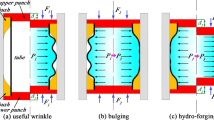Abstract
Axial hydro-forging sequence is an emerging approach in forming the variable-diameter tubes without thinning. However, after the batch production, a barrelling defect occurs at the end of the maximum diameter zone during the process. To investigate the barrelling behavior of the tube in axial hydro-forging sequence, experiments and finite element simulation were carried out in the present work. It could be concluded that the barrelling formation is attribute to the non-uniform stress distribution and the geometric feature of the tube. Subsequently, the effect of expansion ratio, friction coefficient and transition form on barrelling behavior was investigated. It was found that the degree of the barrelling increased with increasing the expansion ratio, but decreased with reducing the friction coefficient. Moreover, the transition form had a significant effect on the barrelling degree, and the barrelling defect can be eliminated when the transition form with circular arc was employed.












Similar content being viewed by others
References
Hartl C (2005) Research and advances in fundamentals and industrial applications of hydroforming. J Mater Process Technol 167(2–3):383–392
Yuan SJ, He ZB, Liu G (2012) New developments of hydroforming in China. Mater Trans 53(5):787–795
Lang LH, Wang ZR, Kang DC, Yuan SJ, Zhang SH, Danckert J, Nielsen KB (2004) Hydroforming highlights: sheet hydroforming and tube hydroforming. J Mater Process Technol 151(1–3):165–177
Li SH, Yang B, Zhang WG, Lin ZQ (2008) Loading path prediction for tube hydroforming process using a fuzzy control strategy. Mater Des 29(6):1110–1116
Manabe KI, Suetake M, Koyama H, Yang M (2006) Hydroforming process optimization of aluminum alloy tube using intelligent control technique. Int J Mach Tools Manuf 46(11):1207–1211
Mirzaali M, Seyedkashi SMH, Liaghat GH, Naeini HM, Shojaee KG, Moon YH (2012) Application of simulated annealing method to pressure and force loading optimization in tube hydroforming process. Int J Mech Sci 55(1):78–84
Abdelkefi A, Guermazi N, Boudeau N, Malécot P, Haddar N (2016) Effect of the lubrication between the tube and the die on the corner filling when hydroforming of different cross-sectional shapes. Int J Adv Manuf Technol 87(1–4):1169–1181
Fiorentino A, Ceretti E, Giardini C (2013) Tube hydroforming compression test for friction estimation-numerical; inverse method, application, and analysis. Int J Adv Manuf Technol 64(5–8):695–705
Han C, Yuan SJ, Sun LN (2008) Reduction of friction and calibration pressure by section preform during hydroforming of tubular automotive structural components. Adv Mater Res 44:143–150
Tabatabaei SA, Panahi MS, Mashhadi MM, Tabatabee SM, Aghajanzadeh M (2013) Optimum design of preform geometry and forming pressure in tube hydroforming using the equipotential lines method. Int J Adv Manuf Technol 69(9–12):2787–2792
Han C, Liu Q, Lu H, Gao GL, Xie WC, Yuan SJ (2018) Thickness improvement in hydroforming of a variable diameter tubular component by using wrinkles and preforms. Int J Adv Manuf Technol 99(9–12):2993–3003
Yuan SJ, Liu G, Lang LH (2003) Numerical simulation of wrinkling in hydroforming of aluminum alloy tubes. Trans Nonferrous Metals Soc China 13(1):152–156
Yuan SJ, Yuan WJ, Wang XS (2006) Effect of wrinkling behavior on formability and thickness distribution in tube hydroforming. J Mater Process Technol 177(1–3):668–671
Lang LH, Li H, Yuan SJ, Danckert J, Nielsen KB (2009) Investigation into the pre-forming's effect during multi-stages of tube hydroforming of aluminum alloy tube by using useful wrinkles. J Mater Process Technol 209(5):2553–2563
Mori K, Maeno T, Maki S (2007) Mechanism of improvement of formability in pulsating hydroforming of tubes. Int J Mach Tools Manuf 47(6):978–984
Elyasi M, Bakhshi-Jooybari M, Gorji A (2009) Mechanism of improvement of die corner filling in a new hydroforming die for stepped tubes. Mater Des 30(9):3824–3830
Han C, Feng H, Yan LD, Yuan SJ (2017) Thickness improvement in non-homogeneous tube hydroforming of a rectangular component by contact sequence. Int J Adv Manuf Technol 92(5–8):2667–2675
Xie WC, Han C, Chu GN, Yuan SJ (2015) Research on hydro-pressing process of closed section tubular parts. Int J Adv Manuf Technol 80(5–8):1149–1157
Chu GN, Sun L, Wang GD, Fan ZG, Li H (2019) Axial hydro-forging sequence for variable-diameter tube of 6063 aluminum alloy. J Mater Process Technol 272:87–99
Plancak M, Vollertsen F, Woitschig J (2005) Analysis, finite element simulation and experimental investigation of friction in tube hydroforming. J Mater Process Technol 170(1–2):220–228
Acknowledgments
This work was funded by the National Natural Science Foundation of China (Grant No.51775134 and No.51475121) and key Research and Development Program of Shandong Province (Grant No.GG201710020004). The authors would like to take this opportunity to express their sincere appreciation to these funding organizations.
Author information
Authors and Affiliations
Corresponding author
Ethics declarations
Conflict of interest
The authors declare no conflict of interest.
Additional information
Publisher’s note
Springer Nature remains neutral with regard to jurisdictional claims in published maps and institutional affiliations.
Rights and permissions
About this article
Cite this article
Sun, L., Yao, S., Li, J. et al. Study on barrelling behavior of variable-diameter tubes in axial hydro-forging sequence. Int J Mater Form 14, 833–841 (2021). https://doi.org/10.1007/s12289-020-01594-5
Received:
Accepted:
Published:
Issue Date:
DOI: https://doi.org/10.1007/s12289-020-01594-5




